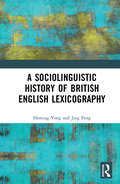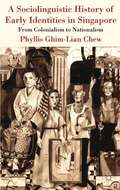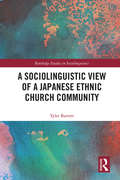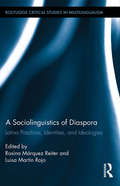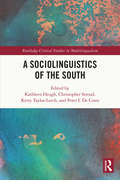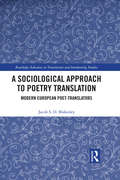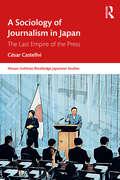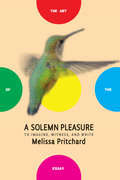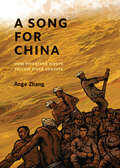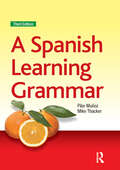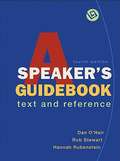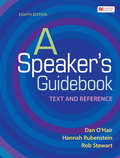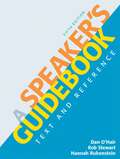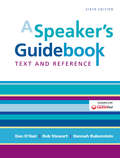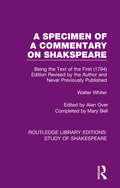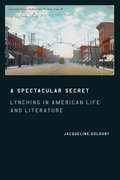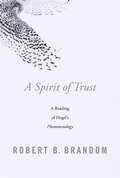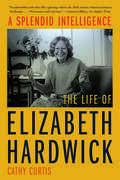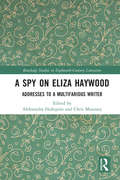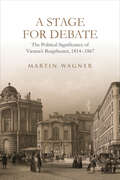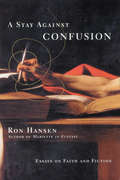- Table View
- List View
A Sociolinguistic History of British English Lexicography
by Heming Yong Jing PengA Sociolinguistic History of British English Lexicography traces the evolution of British English dictionaries from their earliest roots to the end of the 20th century by adopting both sociolinguistic and lexicographical perspectives. It attempts to break out of the limits of the dictionary-ontology paradigm and set British English dictionary-making and research against a broader background of socio-cultural observations, thus relating the development of English lexicography to changes in English, accomplishments in English linguistics, social and cultural progress, and advances in science and technology. It unfolds a vivid, coherent and complete picture of how English dictionary-making develops from its archetype to the prescriptive, the historical, the descriptive and finally to the cognitive model, how it interrelates to the course of the development of a nation's culture and the historical growth of its lexicographical culture, as well as how English lexicography spreads from British English to other major regional varieties through inheritance, innovation and self-perfection. This volume will be of interest to students and academics of English lexicography, English linguistics and world English lexicography.
A Sociolinguistic History of Early Identities in Singapore
by Phyllis Ghim-Lian ChewWhat role does race, geography, religion, orthography and nationalism play in the crafting of identities? What are the origins of Singlish? This book offers a thorough investigation of old and new identities in Asia's most global city, examined through the lens of language.
A Sociolinguistic View of A Japanese Ethnic Church Community (Routledge Studies in Sociolinguistics)
by Tyler BarrettDrawing on sociolinguistic approaches, this book presents unique insights into a Japanese ethnic church community in Canada and the ways in which churches mediate issues of linguistic, cultural, and religious hybridity in addressing the needs of their diverse populations. The book integrates discourse analytic methods with ethnographic perspectives to explore the complex dynamics of negotiating their different members’ preferred language practices. The volume outlines the ways in which ethnic churches in this community build themselves around intentionally preferred Japanese language practices but make accommodations for English-language speakers in their own families, in turn making further accommodations for ESL student speakers new to the country. Barrett explores the impact of church members’ transcultural experiences in broader decisions around language planning and policy in these churches, shedding light on the distinct implications of hybrid identities on discourses in localized communities. // The volume will be of interest to scholars in sociolinguistics, applied linguistics, and religious studies.
A Sociolinguistics of Diaspora: Latino Practices, Identities, and Ideologies (Routledge Critical Studies in Multilingualism)
by Rosina M Luisa MartThis volume brings together scholars in sociolinguistics and the sociology of new media and mobile technologies who are working on different social and communicative aspects of the Latino diaspora. There is new interest in the ways in which migrants negotiate and renegotiate identities through their continued interactions with their own culture back home, in the host country, in similar diaspora elsewhere, and with the various "new" cultures of the receiving country. This collection focuses on two broad political and social contexts: the established Latino communities in urban settings in North America and newer Latin American communities in Europe and the Middle East. It explores the role of migration/diaspora in transforming linguistic practices, ideologies, and identities.
A Sociolinguistics of the South (Routledge Critical Studies in Multilingualism)
by Peter I. De Costa Christopher Stroud Kerry Taylor-Leech Kathleen HeughThis book brings to life initiatives among scholars of the south and north to understand better the intelligences and pluralities of multilingualisms in southern communities and spaces of decoloniality. Chapters follow a longue durée perspective of human co-existence with communal presents, pasts, and futures; attachments to place; and insights into how multilingualisms emerge, circulate, and alter over time. Each chapter, informed by the authors’ experiences living and working among southern communities, illustrates nuances in ideas of south and southern, tracing (dis-/inter-) connected discourses in vastly different geopolitical contexts. Authors reflect on the roots, routes and ecologies of linguistic and epistemic heterogeneity while remembering the sociolinguistic knowledge and practices of those who have gone before. The book re-examines the appropriacy of how theories, policies, and methodologies ‘for multilingual contexts’ are transported across different settings and underscores the ethics of research practice and reversal of centre and periphery perspectives through careful listening and conversation. Highlighting the potential of a southern sociolinguistics to articulate a new humanity and more ethical world in registers of care, hope, and love, this volume contributes to new directions in critical and decolonial studies of multilingualism, and to re-imagining sociolinguistics, cultural studies, and applied linguistics more broadly.
A Sociological Approach to Poetry Translation: Modern European Poet-Translators (Routledge Advances in Translation and Interpreting Studies)
by Jacob S. BlakesleyThis volume provides an in-depth comparative study of translation practices and the role of the poet-translator across different countries and in so doing, demonstrates the need for poetry translation to be extended beyond close reading and situated in context. Drawing on a corpus composed of data from national library catalogues and Worldcat, the book examines translation practices of English-language, French-language, and Italian-language poet-translators through the lens of a broad sociological approach. Chapters 2 through 5 look at national poetic movements, literary markets, and the historical and socio-political contexts of translations, with Chapter 6 offering case studies of prominent and representative poet-translators from each tradition. A comprehensive set of appendices offers readers an opportunity to explore this data in greater detail. Taken together, the volume advocates for the need to study translation data against broader aesthetic, historical, and political trends and will be of particular interest to students and scholars in translation studies and comparative literature.
A Sociology of Journalism in Japan: The Last Empire of the Press (ISSN)
by César CastellviThis book represents an in-depth analysis of journalism in Japan during the golden era of the daily press and the gradual introduction of digital technology starting from the mid-1980s to the late 2010s.By presenting firsthand testimony from journalists and field notes collected from fieldwork in the newsroom of one of the country's largest newspapers, this book provides a unique insight into Japan’s highly active yet relatively under-institutionalized journalistic profession. It also explores the changes experienced by the organizational development of Japanese journalism in response to broader changes in Japanese society, such as the emergence of social networks, the evolution of reading practices, the demographic situation, and the new aspirations of the Japanese youth.Based on an extensive ethnographic fieldwork carried out by the author over several years, this book will be of huge interest to students and scholars of Japanese society, journalism, and media studies.
A Solemn Pleasure
by Bret Anthony Johnston Melissa PritchardPoets & Writers "Best Books for Writers" selectionPublishers Weekly "Top 10: Literary Biographies, Essays & Criticism"In an essay entitled "Spirit and Vision" Melissa Pritchard poses the question: "Why write?" Her answer reverberates throughout A Solemn Pleasure, presenting an undeniable case for both the power of language and the nurturing constancy of the writing life. Whether describing the deeply interior imaginative life required to write fiction, searching for the lost legacy of American literature as embodied by Walt Whitman, being embedded with a young female GI in Afghanistan, traveling with Ethiopian tribes, or revealing the heartrending story of her informally adopted son William, a former Sudanese child slave, this is nonfiction vividly engaged with the world. In these fifteen essays, Pritchard shares her passion for writing and storytelling that educates, honors, and inspires.Melissa Pritchard is the author of, most recently, the novel Palmerino and the short story collection The Odditorium. Her books have received the Flannery O'Connor, Janet Heidinger Kafka, and Carl Sandburg awards and two of her short fiction collections were New York Times Notable Book and Editors' Choice selections. Pritchard has worked as a journalist in Afghanistan, India, and Ethiopia, and her nonfiction has appeared in various publications, including O, The Oprah Magazine, Arrive, Chicago Tribune, and Wilson Quarterly. She lives in Phoenix, Arizona.
A Song for China: How My Father Wrote Yellow River Cantata
by Ange ZhangPublished in celebration of the famous Yellow River Cantata’s 80th anniversary, this is the riveting history of how a young Chinese author and passionate militant fought using art to create a socially just China during the period of the struggle against the Japanese and during World War II.This is the fascinating story of how a young Chinese author, Guang Weiran, a passionate militant from the age of twelve, fought, using art, theater, poetry and song, especially the famous Yellow River Cantata — the anthem of Chinese national spirit — to create a socially just China. Set during the period of the struggle against the Japanese and the war against the Kuomintang in the 1920s and ’30s, this book, written and illustrated by Guang Weiran’s award-winning artist son, Ange Zhang, illuminates a key period in China’s history. The passion and commitment of the artists who were born under the repressive weight of the Japanese occupation, the remnants of the decaying imperial order and the times of colonial humiliation are inspiring.Zhang’s words and wood-block style of art tell us the story of his father’s extraordinary youth and very early rise to prominence due to his great talent with words. We see and hear the intensity of what it meant to be alive at such a significant moment in the history of China, a country that understands itself as the heir to one of the greatest civilizations the world has ever known. The humiliations and social injustice the Chinese people had endured in the colonial period were no longer bearable. And yet there were major factional differences between those who wanted to create a modern China. Ange’s words and art paint the picture for us through his father’s story, accompanied by sidebars that explain the historical context.The book ends in a burst of glorious color and song, with the words of Yellow River Cantata in Mandarin, as well as newly translated into English. This great song turns eighty years old in 2019, and will be sung and performed by huge orchestras and choirs around the world, as the Chinese diaspora has embraced the cantata as its own.Key Text Features historical context sidebars illustrations lyricsCorrelates to the Common Core State Standards in English Language Arts:CCSS.ELA-LITERACY.RI.6.2 Determine a central idea of a text and how it is conveyed through particular details; provide a summary of the text distinct from personal opinions or judgments.CCSS.ELA-LITERACY.RI.6.6 Determine an author's point of view or purpose in a text and explain how it is conveyed in the text.CCSS.ELA-LITERACY.RI.6.7 Integrate information presented in different media or formats (e.g., visually, quantitatively) as well as in words to develop a coherent understanding of a topic or issue.
A Space of Their Own: Women, Writing and Place 1850-1950 (Among the Victorians and Modernists)
by Katie Baker and Naomi WalkerThis collection explores how nineteenth and twentieth-century women writers incorporated the idea of ‘place’ into their writing. Whether writing from a specific location or focusing upon a particular geographical or imaginary place, women writers working between 1850 and 1950 valued ‘a space of their own’ in which to work. The period on which this collection focuses straddles two main areas of study, nineteenth century writing and early twentieth century/modernist writing, so it enables discussion of how ideas of space progressed alongside changes in styles of writing. It looks to the many ways women writers explored concepts of space and place and how they expressed these through their writings, for example how they interpreted both urban and rural landscapes and how they presented domestic spaces. A Space of Their Own will be of interest to those studying Victorian literature and modernist works as it covers a period of immense change for women’s rights in society. It is also not limited to just one type or definition of ‘space’. Therefore, it may also be of interest to academics outside of literature – for example, in gender studies, cultural geography, place writing and digital humanities.
A Space of Their Own: Women, Writing and Place 1850-1950 (Among the Victorians and Modernists)
by Katie Baker and Naomi WalkerThis collection explores how nineteenth and twentieth-century women writers incorporated the idea of ‘place’ into their writing. Whether writing from a specific location or focusing upon a particular geographical or imaginary place, women writers working between 1850 and 1950 valued ‘a space of their own’ in which to work. The period on which this collection focuses straddles two main areas of study, nineteenth century writing and early twentieth century/modernist writing, so it enables discussion of how ideas of space progressed alongside changes in styles of writing. It looks to the many ways women writers explored concepts of space and place and how they expressed these through their writings, for example how they interpreted both urban and rural landscapes and how they presented domestic spaces. A Space of Their Own will be of interest to those studying Victorian literature and modernist works as it covers a period of immense change for women’s rights in society. It is also not limited to just one type or definition of ‘space’. Therefore, it may also be of interest to academics outside of literature – for example, in gender studies, cultural geography, place writing and digital humanities.
A Spanish Learning Grammar (Essential Language Grammars)
by Mike Thacker Pilar MunozA Spanish Learning Grammar, Third Edition , is an innovative reference grammar and workbook suitable for you, whether you are studying Spanish at intermediate or advanced level.Its straightforward explanations of grammar are supported by examples with contemporary vocabulary, humorous cartoon drawings, and plentiful, varied exercises, helping you to grasp often complex points of grammar in an enjoyable way. Its carefully devised two-part structure mirrors the learning process, allowing you to focus on core knowledge first and enabling you to progress confidently to more advanced knowledge at your own pace.Key features for this third edition include: New drawings which illustrate grammar through real-life scenarios New vocabulary bringing you up-to-date with Spanish in the digital agRe-ordering of the section on verbs, making the tenses easier for you to findOnline interactive exercises with audio answers, providing you with invaluable listening and pronunciation practice. To aid your understanding, this third edition also contains a glossary of grammatical terms, useful verb tables and a key to the exercises.Written in the belief that grammar is the key to real communication, this is an essential textbook for any student of Spanish.
A Speaker's Guidebook (4th Edition)
by Dan O'Hair Rob Stewart Hannah RubensteinNow also available with additional coverage of rhetorical theory!A Speaker's Guidebookis the most successful public speaking book in over a decade and the best resource for students both in and outside the classroom. Praised for connecting with students and addressing their most pressing needs, it is the easiest-to-use public speaking text available and the text that studentskeep. This tabbed, comb-bound text covers all topics taught in the introduction to public speaking course. In addition,A Speaker's Guidebookoffers coverage that's useful for a lifetime of public speaking with unparalleled treatment of speaking in other courses and on the job. Now for instructors who teach with a focus on rhetoric and persuasion, we are proud to offer an additional version of the text. A Speaker's Guidebook with The Essential Guide to Rhetoricincludes a full tabbed section that provides brief yet comprehensive coverage of rhetorical theory -- from the classical to the contemporary -- and its practical applications.
A Speaker's Guidebook: Text and Reference
by Dan O'Hair Rob Stewart Hannah RubensteinMake a better speech.Using the tips, resources, and examples found in A Speaker’s Guidebook will help you develop speech-making skills that can extend far beyond the classroom to help you succeed whenever public speaking is necessary.
A Speaker's Guidebook: Text and Reference (5th Edition)
by Dan O'Hair Rob Stewart Hannah RubensteinA Speaker's Guidebook is a groundbreaking public speaking text that offers better solutions to the wide range of challenges that students face. The text covers all the traditional topics, including listening, speaking ethically, managing speech anxiety, analyzing the audience, selecting a topic and purpose, locating and using supporting materials, organizing and outlining ideas, using language, creating presentation aids, delivering the speech, and constructing various speech types.
A Speaker’s Guidebook: Text and Reference
by Rob Stewart Hannah Rubenstein Dan O’hairA Speaker's Guidebook is the best resource for public speaking in the classroom, on the job, and in the community. Praised for connecting with students who use it (and keep it!) year after year, this tabbed, comb-bound text covers all the topics typically taught in the introductory course and is the easiest-to-use public speaking text available. In every edition, including this one, hundreds of instructors have helped with the book focus on overcoming the fundamental challenges of the public speaking classroom. Print and digital tools converge in this edition to help students with every aspect of the speech building process A new, gorgeous collection of speech videos, accompanied by questions, model speech techniques while the adaptive quizzing program, LearningCurve,creates a personalized learning experience adjusted to each individual.
A Specimen of a Commentary on Shakspeare: Being the Text of the First (1794) Edition Revised by the Author and Never Previously Published (Routledge Library Editions: Study of Shakespeare)
by Walter WhiterIf it is not generally known that the foundations of twentieth-century criticism of Shakespeare’s imagery were laid over one hundred and fifty years ago, the explanation lies in the limited availability of the single original edition of Walter Whiter’s Specimen of a Commentary on Shakspeare published in 1794. In an age in which the study of Shakespeare’s characters was of prime interest and importance, Whiter – a classical scholar who took holy orders and ended his life as a country parson – developed a form of textual criticism closely linked to a study of the workings of the human mind: and his book offers a psychological survey of the creative imagination, following the principles laid down in Locke’s Essay on Human Understanding and illustrated by examples from Shakespeare’s plays. In his realization that Shakespeare provides the finest examples of the poetic imagination Whiter is of his time: but in his particular study of the associative powers of such a mind engaged in the process of creation, he is far in advance of his time and has no immediate disciples in the later nineteenth century. In the twentieth century, however, there was an increasing acknowledgement of Whiter’s work and a more frequent appeal for the reissue of his book. Originally published in 1967, the present edition was started in response to that appeal more than ten years before Mr Alan Over’s tragic death in 1964 and incorporates the revisions and additions made by Whiter for his own projected second edition.
A Spectacular Secret: Lynching in American Life and Literature
by Jacqueline GoldsbyThis incisive study takes on one of the grimmest secrets in America's national life—the history of lynching and, more generally, the public punishment of African Americans. Jacqueline Goldsby shows that lynching cannot be explained away as a phenomenon peculiar to the South or as the perverse culmination of racist politics. Rather, lynching—a highly visible form of social violence that has historically been shrouded in secrecy—was in fact a fundamental part of the national consciousness whose cultural logic played a pivotal role in the making of American modernity. To pursue this argument, Goldsby traces lynching's history by taking up select mob murders and studying them together with key literary works. She focuses on three prominent authors—Ida B. Wells-Barnett, Stephen Crane, and James Weldon Johnson—and shows how their own encounters with lynching influenced their analyses of it. She also examines a recently assembled archive of evidence—lynching photographs—to show how photography structured the nation's perception of lynching violence before World War I. Finally, Goldsby considers the way lynching persisted into the twentieth century, discussing the lynching of Emmett Till in 1955 and the ballad-elegies of Gwendolyn Brooks to which his murder gave rise. An empathic and perceptive work, A Spectacular Secret will make an important contribution to the study of American history and literature.
A Spectacular Secret: Lynching in American Life and Literature
by Jacqueline GoldsbyThis incisive study takes on one of the grimmest secrets in America's national life—the history of lynching and, more generally, the public punishment of African Americans. Jacqueline Goldsby shows that lynching cannot be explained away as a phenomenon peculiar to the South or as the perverse culmination of racist politics. Rather, lynching—a highly visible form of social violence that has historically been shrouded in secrecy—was in fact a fundamental part of the national consciousness whose cultural logic played a pivotal role in the making of American modernity. To pursue this argument, Goldsby traces lynching's history by taking up select mob murders and studying them together with key literary works. She focuses on three prominent authors—Ida B. Wells-Barnett, Stephen Crane, and James Weldon Johnson—and shows how their own encounters with lynching influenced their analyses of it. She also examines a recently assembled archive of evidence—lynching photographs—to show how photography structured the nation's perception of lynching violence before World War I. Finally, Goldsby considers the way lynching persisted into the twentieth century, discussing the lynching of Emmett Till in 1955 and the ballad-elegies of Gwendolyn Brooks to which his murder gave rise. An empathic and perceptive work, A Spectacular Secret will make an important contribution to the study of American history and literature.
A Spectacular Secret: Lynching in American Life and Literature
by Jacqueline GoldsbyThis incisive study takes on one of the grimmest secrets in America's national life—the history of lynching and, more generally, the public punishment of African Americans. Jacqueline Goldsby shows that lynching cannot be explained away as a phenomenon peculiar to the South or as the perverse culmination of racist politics. Rather, lynching—a highly visible form of social violence that has historically been shrouded in secrecy—was in fact a fundamental part of the national consciousness whose cultural logic played a pivotal role in the making of American modernity. To pursue this argument, Goldsby traces lynching's history by taking up select mob murders and studying them together with key literary works. She focuses on three prominent authors—Ida B. Wells-Barnett, Stephen Crane, and James Weldon Johnson—and shows how their own encounters with lynching influenced their analyses of it. She also examines a recently assembled archive of evidence—lynching photographs—to show how photography structured the nation's perception of lynching violence before World War I. Finally, Goldsby considers the way lynching persisted into the twentieth century, discussing the lynching of Emmett Till in 1955 and the ballad-elegies of Gwendolyn Brooks to which his murder gave rise. An empathic and perceptive work, A Spectacular Secret will make an important contribution to the study of American history and literature.
A Spirit of Trust: A Reading of Hegel’s <i>Phenomenology</i>
by Robert B. BrandomIn a new retelling of the romantic rationalist adventure of ideas that is Hegel’s classic The Phenomenology of Spirit, Robert Brandom argues that when our self-conscious recognitive attitudes take Hegel’s radical form of magnanimity and trust, we can overcome a troubled modernity and enter a new age of spirit.
A Splendid Intelligence: The Life Of Elizabeth Hardwick
by Cathy CurtisThe first biography of the extraordinary essayist, critic, and short story writer Elizabeth Hardwick, author of the semiautobiographical novel Sleepless Nights. Born in Kentucky, Elizabeth Hardwick left for New York City on a Greyhound bus in 1939 and quickly made a name for herself as a formidable member of the intellectual elite. Her eventful life included stretches of dire poverty, romantic escapades, and dustups with authors she eviscerated in The New York Review of Books, of which she was a cofounder. She formed lasting friendships with literary notables—including Mary McCarthy, Adrienne Rich, and Susan Sontag—who appreciated her sharp wit and relish for gossip, progressive politics, and great literature. Hardwick’s life and writing were shaped by a turbulent marriage to the poet Robert Lowell, whom she adored, standing by faithfully through his episodes of bipolar illness. Lowell’s decision to publish excerpts from her private letters in The Dolphin greatly distressed Hardwick and ignited a major literary controversy. Hardwick emerged from the scandal with the clarity and wisdom that illuminate her brilliant work—most notably Sleepless Nights, a daring, lyrical, and keenly perceptive collage of reflections and glimpses of people encountered as they stumble through lives of deprivation or privilege. A Splendid Intelligence finally gives Hardwick her due as one of the great postwar cultural critics. Ranging over a broad territory—from the depiction of women in classic novels to the civil rights movement, from theater in New York to life in Brazil, Kentucky, and Maine—Hardwick’s essays remain strikingly original, fiercely opinionated, and exquisitely wrought. In this lively and illuminating biography, Cathy Curtis offers an intimate portrait of an exceptional woman who vigorously forged her own identity on and off the page.
A Spy on Eliza Haywood: Addresses to a Multifarious Writer (Routledge Studies in Eighteenth-Century Literature)
by Aleksondra HultquistEliza Haywood was one of the most prolific English writers in the Age of the Enlightenment. Her career, from Love in Excess (1719) to her last completed project The Invisible Spy (1755) spanned the gamut of genres: novels, plays, advice manuals, periodicals, propaganda, satire, and translations. Haywood’s importance in the development of the novel is now well-known. A Spy on Eliza Haywood links this with her work in the other genres in which she published at least one volume a year throughout her life, demonstrating how she contributed substantially to making women’s writing a locus of debate that had to be taken seriously by contemporary readers, as well as now by current scholars of political, moral, and social enquiries into the eighteenth century. Haywood’s work is essential to the study of eighteenth-century literature and this collection of essays continues the growing scholarship on this most important of women writers.
A Stage for Debate: The Political Significance of Vienna’s Burgtheater, 1814–1867 (German and European Studies #49)
by Martin WagnerA Stage for Debate presents a detailed analysis of the repertoire of the leading German-language stage of the nineteenth century, Vienna’s Burgtheater. The book explores the extent to which the Burgtheater repertoire contributed to important political and cultural debates on individual liberty, the role of women in society, and the understanding of national and regional identity. The relevance of the Burgtheater as a forum for political debate is assessed not by the degree to which the performed plays transgressed established norms, but by the range of positions that were voiced on a given topic. Martin Wagner investigates the roughly 1,000 plays from across Europe that were introduced to the Burgtheater’s repertoire between 1814 and 1867 by combining a general overview with detailed interpretations of especially successful plays. Wagner reveals that the Burgtheater was significantly more involved in contemporary debates than the stereotype of this stage as an artistically refined but apolitical institution suggests. Drawing from theatre studies and German and Austrian studies more broadly, A Stage for Debate revises the history of one of Europe’s leading theatres.
A Stay Against Confusion
by Ron HansenIn the tradition of Flannery O'Connor and Andre Dubus, A Stay Against Confusion explores the role that religious belief and literature play in one writer's life. All creative writing is, in the words of Robert Frost, "a stay against confusion." It tries to find a harmony and order that we only fleetingly detect beneath the chaos of everyday life, and to point out motivations and causalities in what seem to be random and often meaningless acts. Religion has also functioned in this way for Ron Hansen, and it shares with literature both a reverence for mystery and the use of metaphor to communicate another order that we will never fully perceive or comprehend.In this rich and deeply felt collection of essays, Hansen talks about his novels, his childhood and family, and about such mentors as John Gardner. He explores prayer, stigmata, twentieth-century martyrs, and the Eucharist. A profile of his grandfather, a "tough-as-nails, brook-no-guff Colorado rancher," finds a place alongside a wonderfully informative portrait of Saint Ignatius of Loyola. A brilliant reading of a story by Leo Tolstoy follows an appreciation of the poetry of Gerard Manley Hopkins. A surprisingly intimate book, A Stay Against Confusion brings together the literary and religious impulses that inform the life of one of our most gifted fiction writers.
